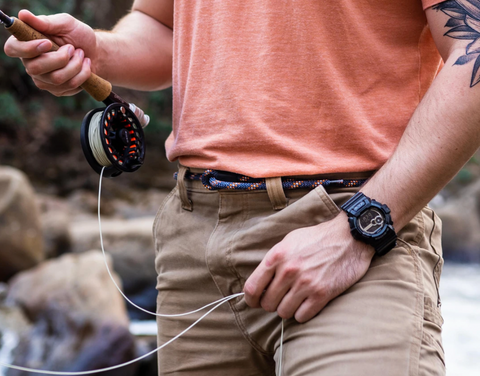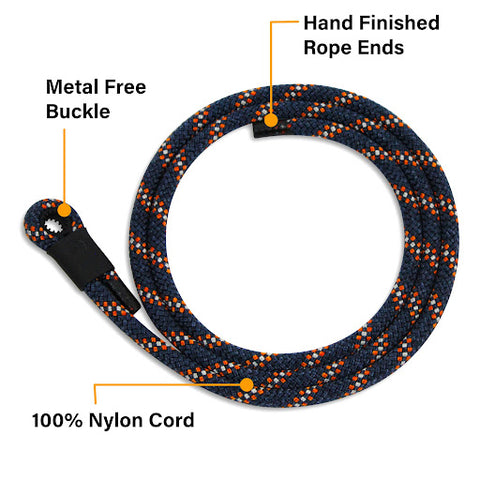How to Make Your Own Rope Belt — The Ultimate DIY Guide

Do you love belts? More specifically, do you love rope belts? It’s hard not to love them. They can be rugged, strong, and they look amazing. They have been used outdoors for many years because of their strength, durability, and emergency use. Women in the fashion industry have also been using rope belts for years as statement pieces. No matter if you’re looking for durability or a fashion statement, rope belts are a great fit for everyone. If you are looking to make your rope belt, here is the ultimate guide to DIY’ing one!
Why a rope belt?
So, why a rope belt? It depends on who you ask. Some people just love how they look. They’re rustic looking, and they’re also a statement piece. Women use them in fashion over dresses all the time.
Rope belts can also be great for people who love the outdoors. The belts are simple, they look great, and they can take a beating. They need to have this durability if you’re out hiking, climbing, camping, backpacking, and more. The other great thing about rope belts is that you can make them yourself. Yes, you can make other types of belts, but the rope belt is much easier to make unless you’re an expert in leatherworking.

Rope belts could also save your life. It might sound dramatic, but it’s true. If you get into an emergency, a piece of rope could very well save your life. Rope can be used to make shelter, snares for hunting, winches, for climbing, for securing things, for towing, etc. If you have another piece of rope fail, you can replace it with rope from your rope belt. There are too many uses to count, but rope belts can be stylish and help you in an emergency.
Where can you wear a rope belt?
So you might be wondering, where can I wear my rope belt? In reality, almost anywhere! Rope belts can be strong and make a cool statement or talking piece. While rope belts are good for outdoor and casual settings, make sure you know your audience for more formal events. A rope belt might clash with a tux at a wedding or might not cut it at the office. It depends on your judgment, though.
Taking measurements
The easiest way to take measurements for your belt is to take a piece of rope and place it around your waist. Make sure you leave enough slack for knots. It’s always easiest if you give yourself a bit more slack than needed because you can always cut off the excess or re-tie the knot if the belt is too big. If you give yourself too little rope to work with, then you’ll have to start over.
You can also take a belt that you know fits you, lay it out flat, and measure it. Then you can take that measurement to measure out your rope. However, again, make sure you’re accounting for the length you’ll need for knots or to secure clasps to the rope.
Rope types
There are many different kinds of rope you could use to make your belt. Just keep in mind that not all ropes are created equal. Some are smoother than others, some are stronger than others, and some are just plain hard to work with. Here are some rope ideas to get you started.
Paracord
Paracord is a pretty readily available rope that is easy to work with and strong. It’s loved by outdoor enthusiasts and survivalists alike. It can be folded and tied into many different shapes and some people even wear braided paracord as bracelets. It can be easily untied and used if you get into a pinch, as well.
Nylon
Nylon rope is smoother and seems more flimsy, but it’s one of the stronger ropes out there. It’s used a lot when people are making winches and pulleys. It has great resistance and shock absorption. It’s also able to stretch and hold big loads–but then it will return to its original length when you’re done. If you use this for a belt, it could come in handy if you get into a pinch while you’re out hiking or camping.
Cotton
Cotton rope is used for things like hammocks, tents, halters for horses, and lead ropes for horses among other things. It’s very soft. So, it won’t hurt or scratch up your skin. Another great thing about cotton rope is that it is braided. Most other ropes just have strands twisted together. The braids make the cotton more sturdy. However, it’s not as strong as the nylon rope.
Any rope you have lying around
Yes, we know you’re wondering… So could you theoretically use any kind of rope you have lying around? Yes and no. If you’re looking to make a fashion statement, and you find a rope that you like the look and feel of, you absolutely can make a belt out of it. However, as mentioned above, not all ropes are created equal. If you want something durable that you could theoretically use in a pinch, then no. You’ll want to think about the thickness, strength, the feel of the rope, and if it can even hold a knot.
There are many types of rope that you can get and braid, tie, or style in different ways. It’s more about the look, feel, and what your purpose with your belt is, more than anything. So, keep that in mind while picking rope for your belt.
All about knots
There are many different kinds of knots that might work for a rope belt. Here are a few ideas to get you started.
Bowknot
You could simply tie the rope around your hips with a bowknot (which is just like how you tie your shoes). It’s an easy knot that we all know, and it makes for the most simple belt. However, these knots can sometimes slip and come undone. If you tie the knot too tight and double-knot it, you also risk having to cut the belt off if you can’t get it undone.
Slip Knot
The best knot for a rope belt would be a slip knot. It’s known as a “stopper knot” which means that it’s used to keep ropes from slipping through a hole. This knot allows you to easily tighten and loosen the belt. It will hold firm and can be flexible, as needed.
Figure-eight Knots
Figure-eight knots are also stopper knots. You might’ve seen them when you go rock climbing. True to your name, they look a lot like a figure eight. They’re sturdy and stay put. So, they could be another knot to consider for your belt.
Clove Hitch Knots
Clove Hitch Knots are not as secure as the knots mentioned above, but they still might be a good candidate for a rope belt knot. They’re a good binding knot, and while you might not want to use it in a life-threatening situation, for a belt, it would be just fine.
Adding Accessories
If you do your research on rope belts, you’ll see that sometimes people add accessories. Instead of using a knot to keep the belt closed, some people tie the rope belt to a carabiner and use that as a makeshift belt clasp. Others just want the look of a rope belt and add an actual belt buckle to the raw or braided rope. This can get complicated, though, as you have to find a way to tie or braid the buckle into the belt, or else it might be too flimsy or loose.
In addition, some people add metal clasps to the ends of the rope they are making a belt with so the rope doesn’t fray. It’s a good idea, but again, it adds another factor to your rope belt that might take away from its simplicity.
You need one of these
While making your rope belt might be fun, consider buying a Lizard Tail rope belt instead. They’re solid, reliable belts that are made from 100% nylon rope. As mentioned above, this is the kind of super-strong rope that climbers rely on when climbing mountains or trees! So, no cheap and flimsy ropes here.
Our belts also utilize knotless technology which makes the belt easy to secure. It also isn’t complicated to get off. So, you won’t have to deal with undoing a complicated knot when you need to change or… ahem… nature calls.

The best part is that our rope belts also come in unique color schemes. So, there’s something for everybody! It also means you can skip all of the braiding, knotting, and picking of rope. SO, you can have a great durable belt without all of the DIY-ing
Rope belts are a pretty great piece to add to your wardrobe. They are an amazing talking piece, they look sharp, and they’re super durable. So, you can’t go wrong with a rope belt.

